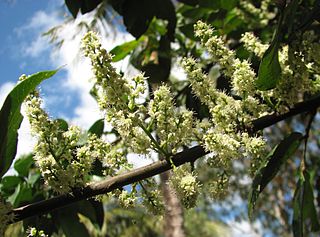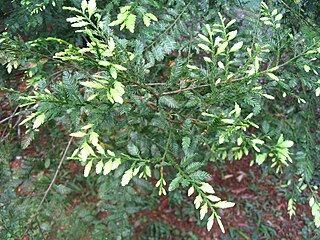
Alectryon is a genus of about 30 species of trees and shrubs from the family Sapindaceae. They grow naturally across Australasia, Papuasia, Melanesia, western Polynesia, east Malesia and Southeast Asia, including across mainland Australia, especially diverse in eastern Queensland and New South Wales, the Torres Strait Islands, New Guinea, the Solomon Islands, New Caledonia, New Zealand, Vanuatu, Fiji, Samoa, Hawaii, Indonesia and the Philippines. They grow in a wide variety of natural habitats, from rainforests, gallery forests and coastal forests to arid savannas and heaths.

Lakeba is an island in Fiji’s Southern Lau Archipelago; the provincial capital of Lau is located here. The island is the tenth largest in Fiji, with a land area of nearly 60 square kilometers. It is fertile and well watered, and encircled by a 29-kilometer road. Its closest neighbors are Aiwa and Nayau. Separated by deep sea from the latter but only by shallow waters from the former, when sea levels were lower during glacial episodes Lakeba and Aiwa formed one large island.

Cupaniopsis is a genus of about 67 species of trees and shrubs of the soapberry family, Sapindaceae. They grow naturally in New Guinea, New Caledonia, Australia, Torres Strait Islands, Fiji, Samoa, Sulawesi, Micronesia. Many species have been threatened with extinction globally or nationally, with official recognition by the International Union for Conservation of Nature (IUCN) and several national and state governments.

Guioa is a genus of about 78 rainforest tree species known to science, which constitute part of the plant family Sapindaceae. They have a wide distribution, ranging from throughout Malesia, in Burma, Cambodia, Vietnam, Thailand, Malay Peninsula, Borneo, Sumatra, Philippines, Java, Flores, Timor, Sulawesi, Moluccas, New Guinea, further southwards through the east coast of Queensland and New South Wales, Australia and further eastwards to the Pacific Islands, including Tonga, New Caledonia, Fiji and Samoa.

Elattostachys is a genus of about 21 species of trees known to science, constituting part of the plant family Sapindaceae.

Dacrycarpus imbricatus is a species of conifer in the family Podocarpaceae. It is found in Cambodia, China, Fiji, Indonesia, Laos, Malaysia, Papua New Guinea, the Philippines, Thailand, Vanuatu, and Vietnam. It is a tall tree up to 40 metres (130 ft) high.
The Fiji Snake, also known as the Bolo Snake, is a species of snake in the family Elapidae. It is monotypic within the genus Ogmodon. It is endemic to Fiji, found only on the island of Viti Levu, and is strongly subterranean.

The Fijian mastiff bat, also known as the Fijian free-tailed bat, is a species of bat in the family Molossidae. It is found in Fiji and Vanuatu. In 2013, Bat Conservation International listed this species as one of the 35 species of its worldwide priority list of conservation. This species is currently listed as endangered and considered a species of special concern due to habitat fragmentation and cave disturbance. The Fijian free-tailed bat is endemic to Fiji and Vanuatu islands. This species was previously documented on the islands of Taveuni and Vanua Levu, current research indicates possible small fragmented populations inhabiting both islands. Only two insectivorous bats occupy Fiji, the Pacific sheath-tailed bat and the Fijian free-tailed bat. Both species consume night flying insects, foraging high above the canopy.
Astronidium lepidotum is a species of plant in the family Melastomataceae. It is endemic to Fiji.
Geissois stipularis is a species of forest trees, constituting part of the plant family Cunoniaceae. They are endemic to Fiji.
Geissois superba is a species of forest trees, constituting part of the plant family Cunoniaceae. They are endemic to Fiji.

Helicia is a genus of 110 species of trees and shrubs, constituting part of the plant family Proteaceae. They grow naturally in rainforests throughout tropical South and Southeast Asia, including India, Sri Lanka, Indochina, Peninsular Malaysia to New Guinea and as far south as New South Wales.
Pandanus joskei is a species of plant in the family Pandanaceae. It is endemic to Fiji.

Protea comptonii, also known as saddleback sugarbush, is a smallish tree of the genus Protea in the family Proteaceae. It is found in South Africa and Eswatini.
Tabernaemontana thurstonii is a species of plant in the family Apocynaceae. It is endemic to Fiji.

Pteralopex is a genus of large megabats in the family Pteropodidae Species in this genus are commonly known as "monkey-faced bats". They are restricted to Solomon Islands rain forests in Melanesia, and all species are seriously threatened, being rated as either endangered or critically endangered by IUCN. Two species, P. taki and P. flanneryi, have been described since 2000.

Metroxylon vitiense is a species of flowering plant in the family Arecaceae, endemic to the islands of Fiji, Ovalau, and Vanua Levu in Fiji. There is only one confirmed occurrence of M. vitiense on Vanua Levu, just outside Savusavu. Despite it being considered a threatened species by the IUCN, as of February 2013 M. vitiense was still unprotected by Fijian regulations and international legislation. It has also been reported from the nearby islands of Wallis and Futuna.

Cossinia is a genus of four species of rainforest trees, constituting part of the plant family Sapindaceae. The genus has a disjunct distribution, occurring in Mascarene Islands, Australia, New Caledonia and Fiji.
Geissois denhamii is a species of forest trees endemic to the island nation of Vanuatu in the Pacific.
The Chestnut-throated flycatcher is a species of bird in the monarch-flycatcher family Monarchidae. The species is endemic to Fiji.













